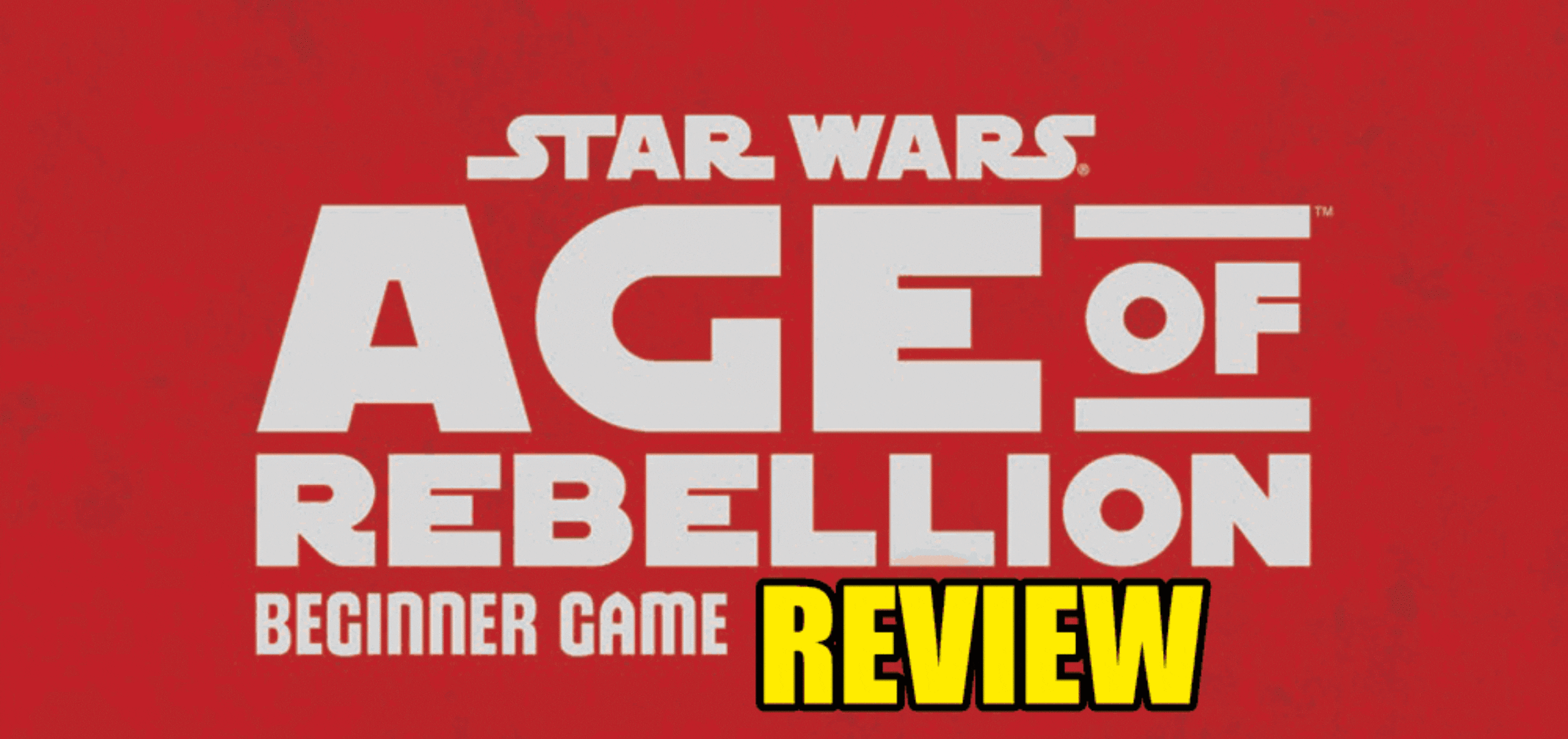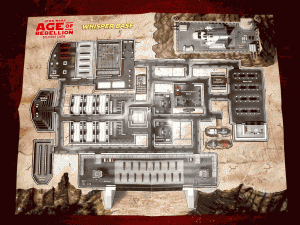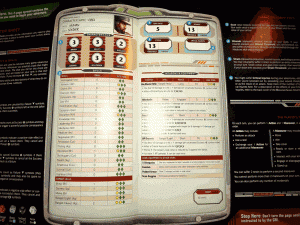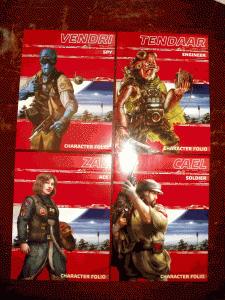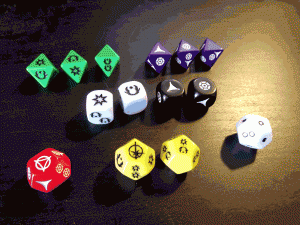It wasn’t until a couple years ago that my long interest in tabletop rpgs was fulfilled when a friend of mine invited me to his weekly Dungeons and Dragons group. The weekly sessions have become something that I look forward to every week. I recently started looking into other systems and worlds mostly just out of curiosity, then I came across Fantasy Flight Games’ recently released Star Wars system. My interest was piqued because I’m a big fan of Star Wars, and because Fantasy Flight Games is a local business to where I live. I recently had the opportunity to GM a session, and here is my review of the experience.
Fantasy Flight took an interesting approach in that they broke the entire world up into three parts primarily based on setting. Though all a part of the same system and world, each part has some unique features. These unique qualities are primarily classes and characters you can expect to encounter in your adventures.
The first set, Edge of the Empire, was released in 2013 and focused on the outskirts of civilization where rogues and bounty hunters are common occurrences and the reach of the law is pretty limited at best. The next set, Age of Rebellion, was released in 2014 and focused on the struggle between the Empire and the Rebels. In this set you are actively engaging stormtroopers on the front lines and play as trained soldiers, spies, and various other military personnel. The final installment, Force and Destiny, is set to release later this year and focuses on those that are sensitive to the Force and are emerging as those who can wield it. Under Imperial law, how will they respond? Try to rebuild the Jedi order? Join the Dark Side and rise to power within the Empire? Either way it’s an exciting time for the galaxy.
I purchased the Age of Rebellion Beginners Game to dive into the world of Star Wars. Two reasons for this decision: first, this is the version the game shop had in stock; second, I realized that the people I planned on playing with would probably like this setting better.
Included in the kit is an intro sheet, a set of specialized dice, an adventure book, 4 character folios, a sheet of thick cardboard printed tokens, a full color map, and a basics rule book. Each piece is beautifully printed and really fun to look at. I was particularly impressed by the character folios: full color print with artist depictions of the character, all stats and equipment filled in easy to read, multiple pages walking you through upgrading your character, and a fun little character background to help you get into the role. All the artwork is really well done and detailed and helps draw you into the world that Fantasy Flight Games has provided.
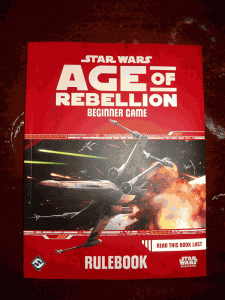
The dice is a collection of mostly 8 sided dice, with a few 12 and 6 sided dice, featuring unique symbols and colors that the entire system is based around. The system most simply said is based on success vs fail with a reward or penalty possible. In more detail, each symbol has a counter that can cancel it out, the most basic being the 8-sided green ability die and purple difficulty die, moving into the 12-sided yellow proficiency die and red challenge die, the 6-sided blue booster die and black setback die, and finally the 12-sided white Force die. For all attacks, and any skill checks, the player gathers the ability and proficiency dice as indicated by their character. The GM then will add the difficulty and challenge dice, determining how hard the desired action is to perform. After that the GM adds any boost or setback dice appropriate to the conditions that may impact the success of an action. Finally players and GM can use any destiny points (the number is determined by each player rolling the force die) available to upgrade a die. The force points are an interesting wild card. Players can only use any light side points available to upgrade an ability die to a proficiency die and the GM can use a dark side point to upgrade a difficulty die to a challenge die. Once a point is used it is flipped becoming available for the opposite side. Putting a little more power into the hands of the players and GM over the probability of success or failure.
Once the dice pool is assembled and rolled, success or failure is determined by the symbols. Success is achieved if you have at least one more success than failure showing. Other symbols represent advantage and threat, whichever symbol has more showing impacts the situations either positively or negative. Lastly, there are triumph and despair symbols which have a much more extreme effect on the situation. So with this system it’s possible to completely fail an action, yet have something positive happen, or vice versa. For example. “Your blaster rifle shot misses, hitting a stack of barrels knocking them over and distracting your target. Your target will have an extra setback dice on their next attack.” Just as plausible. “You successfully splice into the computer granting you access to the files, however you only have time to read a few files before a signal will be sent alerting others to your presence.” This system may seem complicated at first but my group had little trouble picking it up and it wasn’t long before all of us had a strong understanding of how it all worked.
This system led to some really fun and interesting situations that, as the GM, had me pushing my creative storytelling to keep the adventure moving and the players problem solving skills. Being my first opportunity to GM it was difficult at times to come up with how the rolls reflected into the adventure, however the players were always interested in how it played out. The system does offer some basics to follow to make it easier to determine what happens, and how it may impact players, future dice pools, or environment. Players can ask to use advantage to heal strain, gain boost dice, or suggest a benefit they have in mind. GM can use the threats to cause strain, add setback dice, or introduce an appropriate threat.
Damage can be dealt via strain or wounds, and every character has a threshold for both. Every character also has a soak value, which lowers the amount of damage they take. Damage is based on the weapon’s base damage, and any success symbols above and beyond the one required to make the attack a success add to that damage.
The adventure included involves your little band of rebels infiltrating an Empire base with a number of mission objectives. Each encounter of the adventure introduces a new aspect of the system, teaching both the GM and players how to play. It’s very well organized, well explained, and helps keep the whole thing from being overwhelming. It wasn’t long before everyone playing had a firm concept of how the game worked and were easily keeping the story moving through their responses and problem solving. The adventure is structured into two main parts to be easily completed in two shorter sessions or one longer session. We had so much fun we played well into the night and completed the entire adventure in one session. By the end we had dealt with different kinds of combat scenarios, used various skills to gain access to computers, sabotage vehicles, deceive enemy soldiers, and chase the enemy through the jungle on speeder bikes and AT-STs. It all made for a pretty exciting adventure.
One of the sheets included mentioned that there was an additional two characters (in case of bigger group or more variety in character options) and an adventure add-on continuing where the included adventure left off, free to download. I noticed that there was also additional content for The Edge of the Empire setting, character sheet pdf, and other player resources. There is also a Star Wars dice app for $5 available for both iOS and Android. A physical set of dice runs about $15. It was really nice to see the additional resources available to players, showing how much support you can expect for the game in the future.
In conclusion, Fantasy Flight Games’ Star Wars RPG is a really fun system that results in some really interesting storytelling beyond just hitting or missing and succeeding or failing. With the added bonus of being in the Star Wars universe, one of the best settings someone could adventure in. I look forward to playing more of this system, and eventually playing in each of the three core settings.

